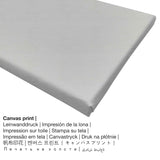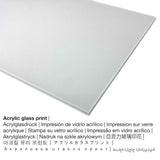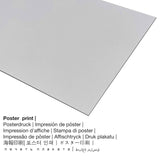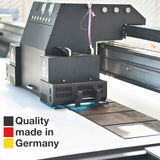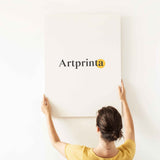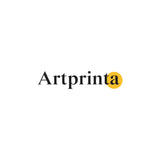Adriaen Pietersz van de Venne, 1618 - Prince Maurice na Frederick Henry na Valkenburg - ọmarịcha akwụkwọ nka.
Ụtụ gụnyere. Mbupu gbakọrọ na ndenye ọpụpụ.
Onyinye ngwaahịa ebipụta
a nka ochie artwork "Prince Maurice and Frederick Henry at the Valkenburg" was made by Adriaen Pietersz van de Venne. Enwere ike ilele ihe nka na n'ime Rijksmuseum's nchịkọta dijitalụ. Site n'ikike nke - Rijksmuseum (ikike ngalaba ọha).E wezụga nke ahụ, ọrụ nka nwere akara aka: . Na mgbakwunye na nke ahụ, nhazi nke mmepụta dijitalụ bụ odida obodo ya na oke nke 5: 2, nke pụtara na ogologo bụ ugboro abụọ na ọkara ogologo karịa obosara.
Họrọ ụdị ihe onwunwe gị
The product dropdown menu gives you the opportunity to choose your prefered size and material. The following options are available for individualization:
- Mpempe akwụkwọ ederede (akwa akwa akwa): Our poster print is a UV printed flat canvas with a granular texture on the surface. It is used for putting your art copy with a customized frame. Please note, that depending on the size of the canvas poster print we add a white margin 2-6cm round about the print motif in order to facilitate the framing with your custom frame.
- Mbipụta kanvas: The printed canvas, which shall not be confused with an artwork painted on a canvas, is a digital replica printed from a UV direct printer. A canvas produces a extra effect of three-dimensionality. Also, a canvas generates a homelike and positive feeling. A canvas of this artpiece will allow you to transform your fine art print into a large collection piece like you know from galleries. The advantage of canvas prints is that they are relatively low in weight, which means that it is easy and straightforward to hang your Canvas print without the use of additional wall-mounts. That is why, canvas prints are suited for all types of walls.
- Glass acrylic ebipụtara nwere mmetụta na-egbuke egbuke (ya na mkpuchi iko n'ezie): A glossy print on acrylic glass, often referred to as a plexiglass print, transforms the original into beautiful home décor. Above all, it offers a distinct alternative to dibond and canvas art prints. The artwork is made with modern UV printing machines. The result of this are impressive, intense colors. The major upside of a plexiglass art print is that contrasts and painting details become exposed thanks to the delicate tonal gradation of the picture.
- Mbipụta nke aluminom: Aluminium Dibond prints are metal prints with a true depth. The Aluminium Dibond Print is the ideal introduction to art prints on aluminum. For your Aluminium Dibond option, we print the chosen artpiece on the aluminium composite surface. The white and bright parts of the artpiece shimmer with a silk gloss but without glow. Colors are vivid and luminous in the highest definition, the details of the print appear clear and crisp. This direct print on Aluminum Dibond is one of the most popular entry-level products and is a truly contemporary way to showcase art, as it draws focus on the replica of the artwork.
Disclaimer: We try the best we can in order to depict the art products in as much detail as it is possible and to illustrate them visually. Nonetheless, the tone of the printed materials and the print result might vary to a certain extent from the presentation on the device's monitor. Depending on the screen settings and the condition of the surface, color pigments might not be printed 100% realistically. Since all the fine art prints are printed and processed manually, there might as well be slight discrepancies in the motif's size and exact position.
Nkọwapụta ngwaahịa
| Nkewa edemede: | ọmarịcha nka |
| Usoro mmeputakwa: | dijitalụ mmeputakwa |
| Usoro mmepụta: | UV kpọmkwem obibi |
| Mmalite nke ngwaahịa a: | German mmepụta |
| Stockdị ngwaahịa: | na mmepụta ihe |
| A na-atụ aro iji ngwaahịa eme ihe: | ime ụlọ, ihe ndozi mgbidi |
| Ndepụta: | nhazi odida obodo |
| Oke akụkụ: | 5: 2 - ogologo: obosara |
| Mmetụta akụkụ: | ogologo bụ ugboro abụọ na ọkara ogologo karịa obosara |
| Akụrụngwa dị: | acrylic glass print (nwere ezigbo mkpuchi iko), mbipụta akwụkwọ mmado (akwụkwọ kwaaji), mbipụta ọla (aluminium dibond), mbipụta akwụkwọ. |
| Mbipụta kanvas (akwa akwa n'elu etiti ihe ndọtị) ụdị nha dị iche iche: | 50x20cm - 20x8", 100x40cm - 39x16", 150x60cm - 59x24" |
| Mpempe iko acrylic (nwere ezigbo mkpuchi iko) nha dị iche iche: | 50x20cm - 20x8", 100x40cm - 39x16", 150x60cm - 59x24" |
| Ụdị akwụkwọ mmado (akwụkwọ kwaaji) dị iche iche: | 100x40cm - 39x16" |
| Ụdị nha ebipụta aluminom: | 50x20cm - 20x8", 100x40cm - 39x16" |
| Nhazi nke nnomi nka: | na-enweghị etiti |
Nkọwa gbasara ọrụ nka mbụ
| Aha nka: | "Prince Maurice and Frederick Henry at the Valkenburg" |
| Nhazi nke ihe nka: | sere |
| Okwu nche anwụ: | nka ochie |
| Time: | 17th narị afọ |
| Afọ okike: | 1618 |
| Afọ nka: | karịa afọ 400 |
| Ụlọ ihe ngosi nka / ebe: | Rijksmuseum |
| Ebe ebe ngosi nka: | Amsterdam, Netherlands |
| URL webụ: | Rijksmuseum |
| Ụdị ikike nka: | ngalaba ọha |
| Site n'aka: | Rijksmuseum |
Nchịkọta dị mkpirikpi nke onye na-ese ihe
| Aha onye nka: | Adriaen Pietersz van de Venne |
| Gender: | nwoke |
| Nationality: | Dutch |
| Ọrụ: | onye na-ese ihe |
| Mba onye si: | mba netherland |
| Otu nka: | nna ukwu ochie |
© Nchekwa ikike nwebisiinka | Artprinta.com (Artprinta)
Ozi izugbe sitere na ụlọ ngosi nka (© - Rijksmuseum - Rijksmuseum)
Van de Venne uses the arrival of Prince Maurice and his younger brother Frederick Henry – in a carriage drawn by six grey horses – to underscore the contrast between the elegant conduct of Hague courtiers and the boorish manners of the peasants. The artist captures the atmosphere of the fair with vignettes of a singer and a woman selling fruit and vegetables whose purse is being picked.


